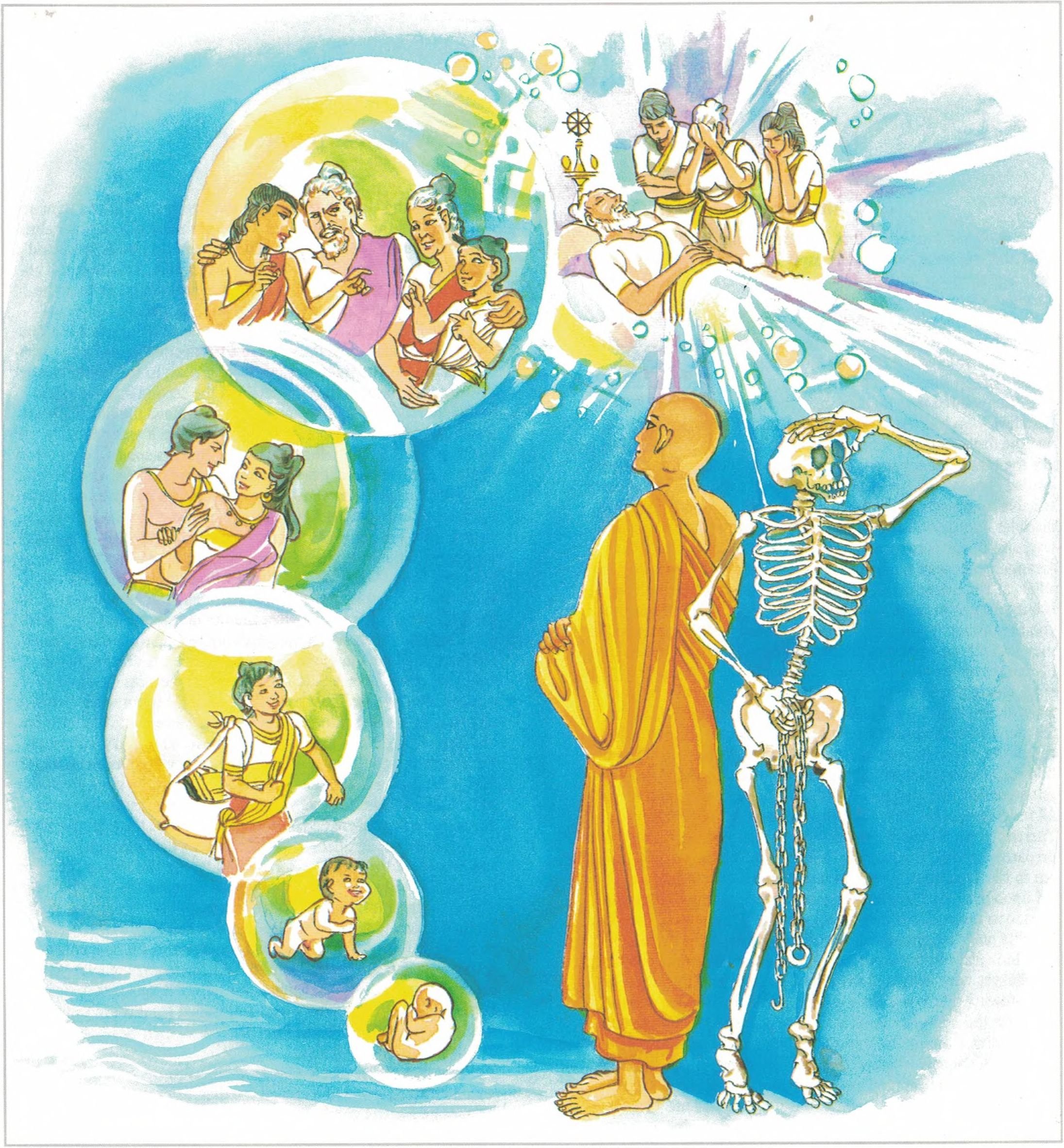Dhammapada (Illustrated)
by Ven. Weagoda Sarada Maha Thero | 1993 | 341,201 words | ISBN-10: 9810049382 | ISBN-13: 9789810049386
This page describes The Story of Many Monks which is verse 170 of the English translation of the Dhammapada which forms a part of the Sutta Pitaka of the Buddhist canon of literature. Presenting the fundamental basics of the Buddhist way of life, the Dhammapada is a collection of 423 stanzas. This verse 170 is part of the Loka Vagga (World) and the moral of the story is “With correct vision of life one slips out of Death’s grip”.
Verse 170 - The Story of Many Monks
Pali text, illustration and English translation of Dhammapada verse 170:
yathā bubbulakaṃ passe yathā passe marīcikaṃ |
evaṃ lokaṃ avekkhantaṃ maccurājā na passati || 170 ||
170. Just as a bubble may be seen, just as a faint mirage, so should the world be viewed that the Death-king sees one not.
 With correct vision of life one slips out of Death’s grip. |
The Story of Many Monks
While residing at the Jetavana Monastery, the Buddha spoke this verse, with reference to a group of monks.
On one occasion, a large number of monks, after taking a meditation topic from the Buddha, went into the forest to practice meditation. But they made very little progress: so they returned to the Buddha to ask for a more suitable subject of meditation. On their way to the Buddha, seeing a mirage they meditated on it. As soon as they entered the compound of the monastery, a storm broke out: as big drops of rain fell, bubbles were formed on the ground and soon disappeared. Seeing those bubbles, the monks stated, “This body of ours is perishable like the bubbles… and perceived the impermanent nature of the aggregates (khandhas). At the end of the discourse, the monks attained arahatship.
The Buddha saw them from his perfumed chamber and sent forth the radiance and appeared in their vision.
Explanatory Translation (Verse 170)
bubbulakaṃ yathā passe, marīcikaṃ yathā passe,
evaṃ lokaṃ avekkhantaṃ maccurājā na passati
bubbulakaṃ [bubbulaka]: a water bubble; yathā: like; passe: one sees; marīcikaṃ [marīcika]: the mirage; evaṃ: in that manner; lokaṃ [loka]: the world; avekkhantaṃ [avekkhanta]: the person who looks at; maccurājā: the king of Death; na passati: does not see
Look at a bubble. How impermanent is it? Look at a mirage. What an illusion! If you look at the world in this way, even the king of death will not see you.
Commentary and exegetical material (Verse 170)
lokaṃ: the world. loka denotes the three spheres of existence comprising the whole universe, i.e.
- the sensuous world (kāma-loka), or the world of the five senses:
- the form world (rūpa-loka), corresponding to the four levels of mental repose (jhāna):
- the formless world (arūpaloka), corresponding to the four mental vacancies (samāpatti).
The sensual world comprises:
- the hells (niraya),
- the animal kingdom (tiracchāna-yoni),
- the ghost-realm (peta-loka),
- the world of asura demons (asura-nikāya),
- the human world (manussa-loka) and
- the six sensual celestial worlds.
bubbulakaṃ, marīcikaṃ: a bubble, a mirage. This stanza reveals an aspect of Buddhist meditation. The meditator looks at the world as a phenomenon.
Elsewhere, sensation is compared to a fountain and perception to a mirage. Sensation and perception are the basic elements of experience. They are called mental constructs (citta-sankhāra). Conception (vitakka) is called a verbal construct (vacī-sankhāra). The world we perceive and conceive is a creation of these transitory psychophysical processes. This is why the world has to be seen as a fountain or a mirage. By seeing the emptiness of the world this way, all attachment ceases.
